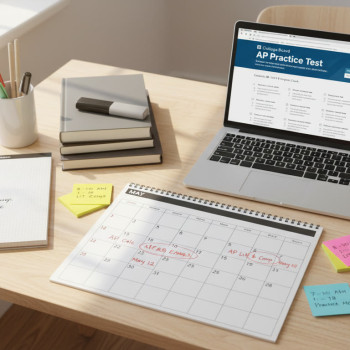Durham: Subject-Specific AP Profiles — A Student’s Guide to Mastering Each Course
Walking into the world of Advanced Placement can feel like stepping into a library where every shelf hums with potential — and a little anxiety. Durham’s subject-specific AP profiles don’t promise a single secret to success; they offer something better: a map. This blog unpacks tailored strategies for the most popular AP subjects, translates exam expectations into day-to-day work, and offers practical study rhythms you can actually live with. Whether you’re a student balancing sports and APs, or a parent trying to support a high-achieving teen, this guide speaks directly to the choices that move scores — and confidence — forward.
How to Use This Guide
Think of each subject profile as a short playbook: what colleges look for, the structure of the exam, high-yield topics, study rituals that work, and small wins to track weekly. I’ll weave in examples, realistic timelines, and how 1-on-1 support — like Sparkl’s personalized tutoring — can fit naturally into your plan without taking over family life.

1. AP Calculus AB & BC: The Two Lanes of the Same Highway
Why it matters: Calculus demonstrates quantitative reasoning and problem-solving — skills colleges value across STEM and economics. AB covers single-variable differential and integral calculus; BC includes everything in AB plus sequences, series, and more advanced integration techniques.
Exam Structure & What to Prioritize
- Multiple-choice and free-response combined; full points go to clarity of method, not just the final answer.
- High-yield topics: limits, derivatives, integrals, the Fundamental Theorem of Calculus, parametric/polar forms (BC), and convergence tests (BC).
- Show your work. Annotate steps briefly if you use a calculator; partial credit is common when your reasoning is clear.
Weekly Routine That Works
- 2–3 short practice problems daily rather than a marathon study night once a week.
- One focused review session per week on a single concept (e.g., series convergence) with 3 example problems of ascending difficulty.
- Monthly timed practice sets that mimic the test format to build pacing confidence.
| Topic | Percent of Exam (Approx.) | Study Focus |
|---|---|---|
| Limits and Continuity | 10–15% | Graph interpretation; algebraic manipulation |
| Derivatives | 20–30% | Applications: motion, optimization |
| Integrals | 20–30% | Technique and interpretation |
| Series (BC) | 10–15% | Convergence tests, power series |
How Tutoring Helps
For many students, a few targeted 1-on-1 sessions transform vague understanding into reliable problem-solving patterns. Sparkl’s personalized tutoring can provide tailored practice problems, instant feedback on problem setup, and pacing strategies — especially helpful for students transitioning from learning to apply concepts under timed conditions.
2. AP Biology: From Memorization to Synthesis
Why it matters: AP Biology is dense — it rewards students who can link concepts across levels, from molecular mechanisms to ecosystems. Colleges look for the ability to synthesize information, design experiments, and interpret data.
Core Content & Exam Tips
- High-yield areas: cellular respiration/photosynthesis, genetics and inheritance, evolution, ecology, and gene expression.
- Practice data interpretation: the exam often includes graphs and experimental scenarios rather than rote recall.
- Use concept maps to connect processes (e.g., how changes in gene expression influence physiology and ecology).
Study Strategy
- Create weekly concept maps; add new connections rather than redoing old notes.
- Build a lab-skills checklist and practice interpreting short experiment vignettes aloud or with peers.
- Use spaced repetition for essential vocabulary, but spend more time applying terms in novel contexts.
Sample Week (for a busy student)
- Mon: 30 minutes — concept map update (metabolism).
- Wed: 30 minutes — data interpretation practice (graph analysis).
- Fri: 45 minutes — practice free-response question and review model answer.
- Sun: 60 minutes — lab-skill focus and cumulative review.
3. AP English Language & Composition and AP English Literature
Why it matters: Both courses sharpen reading, argumentation, and rhetorical analysis — skills valuable across majors. Language emphasizes rhetoric and effective argument; Literature focuses on close reading and interpretive writing.
Exam Blueprint & Skills
- Multiple-choice sections test close reading and rhetorical analysis under time pressure.
- Free-response requires organized, evidence-backed essays with clear thesis and structure.
- Practice synthesizing quotations into your argument rather than letting them stand alone.
Practice That Pays Off
- Daily reading habit: 20–30 minutes of essays or literary excerpts, annotated with a one-sentence purpose statement.
- Weekly timed writings: 40–55 minute essays with peer or tutor feedback to refine clarity and structure.
- Collect a small bank of ‘go-to’ evidence: 6–8 quotations or rhetorical moves you understand deeply and can adapt to multiple prompts.
4. AP U.S. History (APUSH) & AP World History
Why it matters: History courses test chronological thinking, causation, continuity and change, and evidence-backed argumentation. Admissions appreciate applicants who can contextualize and think historically about contemporary issues.
High-Yield Habits
- Make timelines that are visual and modular; group events into themes for easier recall.
- Practice short thesis-driven responses regularly — strong introductions guide high-scoring essays.
- Learn to analyze primary sources: identify author, purpose, audience, and bias quickly.
Table: Essay Types & Quick Strategies
| Essay Type | Goal | Quick Strategy |
|---|---|---|
| DBQ (Document-Based Question) | Use documents to support an argument. | Spend 10–15 min reading docs and planning; group docs into 3–4 themes. |
| LEQ (Long Essay Question) | Develop an original thesis and support it with specific evidence. | Create a two-part outline: thesis + 3 evidence-driven body paragraphs. |
5. AP Physics 1 & 2, and AP Physics C
Why it matters: Physics shows physics literacy and quantitative reasoning. The algebra-based Physics 1 and 2 differ from calculus-based Physics C; choose based on your math background and future major.
What Colleges Notice
- Strong performance indicates rigorous analytical thinking.
- Physics C is especially valued by engineering programs because it mirrors university-level mechanics and E&M topics.
Study Checklist
- Master laboratory reasoning: prediction, control variables, and error analysis.
- Practice problem setup: free-body diagrams, clear coordinate choices, and unit tracking.
- Timed practice for multiple-choice; formula familiarity is vital but so is conceptual intuition.
6. AP Computer Science A
Why it matters: This AP is essentially an introduction to programming in Java and computational problem solving. It’s a signal for colleges that you can think algorithmically and write correct code under constraints.
Key Moves
- Code often: short daily coding exercises beat a weekend marathon.
- Understand returned values and object behavior — many mistakes are conceptual errors in how objects interact.
- Practice tracing code by hand; this is a frequent exam task and clarifies runtime behavior.
7. Cross-Subject Strategies That Move Scores
Small habit changes often yield bigger returns than extra hours. Here are cross-cutting strategies that work for any AP subject.
Active Review Over Passive Re-Reading
- Transform notes into questions. Test yourself — aloud or with a partner.
- Use short, frequent retrieval practice sessions (15–25 minutes) rather than re-reading for hours.
Build a Test-Day Checklist
- Materials: two pencils, approved calculator (if allowed), ID, snacks, and a watch for pacing.
- Logistics: know the testing center route and arrival time; have a quiet warm-up routine (5–10 minutes of light review).
Example Pacing Template (8-week ramp-up)
| Weeks Before Exam | Focus | Weekly Time |
|---|---|---|
| 8–6 | Cover all content areas; identify weak spots | 6–8 hours |
| 5–3 | Practice under timed conditions; refine strategy | 8–10 hours |
| 2–1 | Polish, light review, rest | 4–6 hours |
8. Balancing APs, Mental Health, and College Goals
Top scores are valuable, but they’re a piece of a larger puzzle. Admissions teams look for intellectual curiosity, resilience, and growth. If the workload starts to damage sleep, relationships, or intrinsic motivation, it’s time to recenter.
Practical Trade-Offs
- Quality over quantity: three well-chosen APs with depth usually outshine seven superficial ones.
- Keep an end-of-semester checkpoint: ask whether a course is advancing your long-term goals or simply adding stress.
- Use guided tutoring to target weak areas, freeing up time and reducing anxiety — Sparkl’s 1-on-1 tutoring can be scheduled flexibly to fit into busy lives.
9. Parent Playbook: How to Support Without Steering
Parents play a crucial role when support is steady, practical, and emotionally tuned. Here are simple, supportive moves that help more than pressure.
Concrete Ways to Help
- Create dependable logistics: study-friendly space, predictable meals, and a calendar that clearly marks exam and practice-test dates.
- Ask process-focused questions: “What are you trying to master this week?” rather than “What score do you want?”
- Consider paid support: targeted tutoring sessions can be a wise investment if they reduce study time and increase score efficiency. Sparkl’s personalized tutoring is one option that many families find helpful because it blends expert tutors, tailored study plans, and AI-driven insights to track progress.
10. Putting It Together: A Sample Subject-Specific Plan for ‘Durham’ Students
Imagine a high school junior — call them Durham — juggling AP Calculus BC, AP Biology, and AP English Language. Here’s a practical, balanced plan for a semester.
Weekly Snapshot
- Mon: Calculus practice set (45 minutes) + short biology retrieval practice (20 minutes).
- Tue: English timed writing (50 minutes) with immediate self-review (15 minutes).
- Wed: Group lab review or tutoring session for Biology (1 hour) — rotate weekly between content and data analysis.
- Thu: Calculus timed section (30 minutes) + light reading (20 minutes).
- Fri: Restorative study: 45 minutes of mixed spaced repetition and one free-response question.
- Sat: 90-minute mixed-practice block (one subject deep-dive each week; rotate depths).
- Sun: Planning and light review; prep next week’s goals (30–45 minutes).
How to Use Tutoring Strategically
Reserve tutoring for the hardest, highest-leverage spots: transition points (e.g., moving from AP Calculus AB to BC), or timed-writing skills where feedback shortens the learning loop. Sparkl’s model of personalized schedules and expert tutors can slot into the week above for one focused session (60–90 minutes) that targets the single biggest blocker — then Durham practices that skill in short daily bursts independently.
11. Final Thoughts: Mastery Is a Series of Small Decisions
AP success isn’t magic — it’s a series of small, consistent decisions: choosing the right subjects, practicing deliberately, and asking for help early. Whether you’re aiming for a 5 or trying to strengthen your academic profile, treat this process like a craft. Celebrate small wins: a clear thesis, a solved problem, an experiment interpreted correctly. Over time, those small wins add up to something larger than a test score — they build habits and confidence that will carry into college and beyond.
If you’d like a tailored, subject-by-subject plan based on current course load and goals, consider a short diagnostic session with a tutor who can translate your profile into a weekly plan. Personalized support can make study time smarter, not longer — and keep the learning joyful.

A Quick Checklist to Start Tomorrow
- Pick one subject to focus on this week and list three concrete goals.
- Schedule two short, timed practice sessions (30–60 minutes total) and one review session with targeted feedback.
- Identify one concept to ask for help on — either from a teacher, peer, or a 1-on-1 tutor — and set a specific time to address it.
The AP journey is personal. The right mix of disciplined practice, restful balance, and targeted help will get you there. Treat your study plan like a blueprint: revise it, test it, and make sure it reflects who you are and where you want to go.
Good Luck — and Keep the Curiosity
Scores matter, but the curiosity and habits you build while preparing matter more. Be kind to yourself, celebrate incremental progress, and use resources — including personalized tutoring — to turn pressure into momentum. Durham’s subject-specific approach is not about copying someone else’s path; it’s about crafting a route that fits your strengths and opens the doors you want to walk through.























No Comments
Leave a comment Cancel